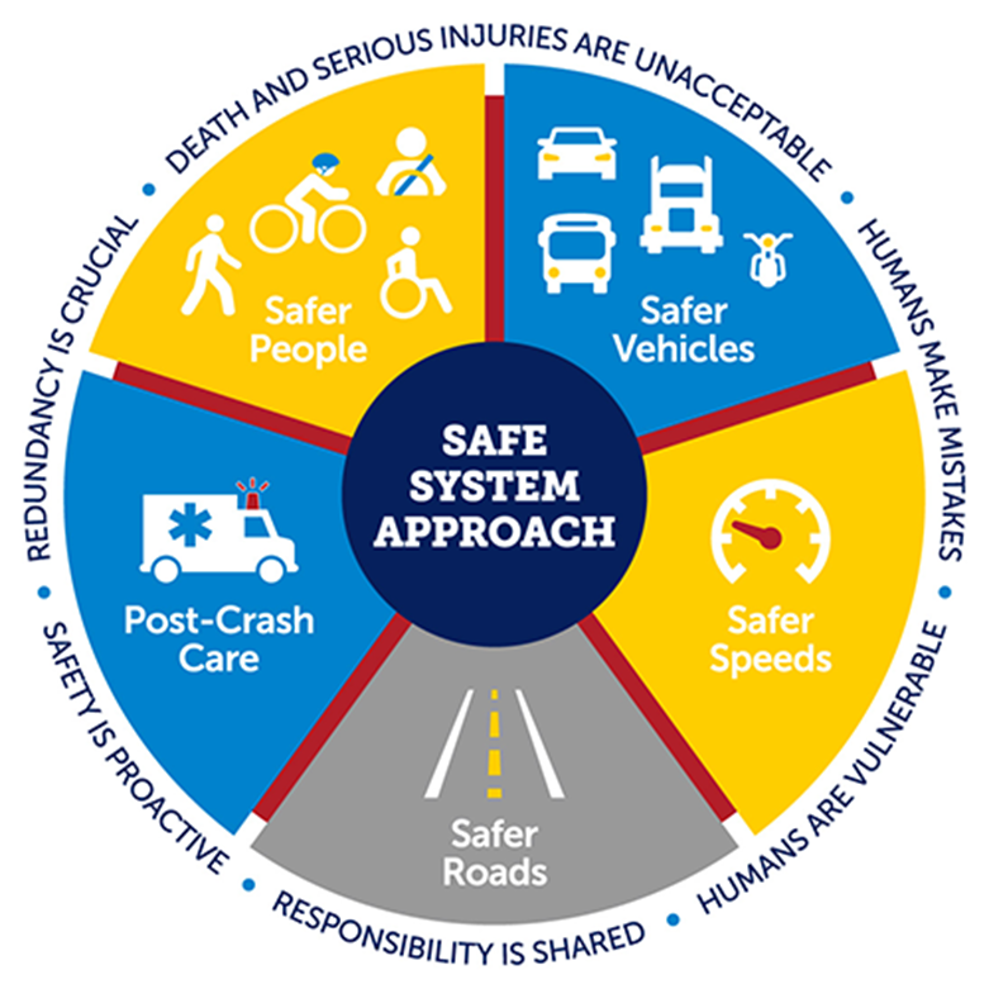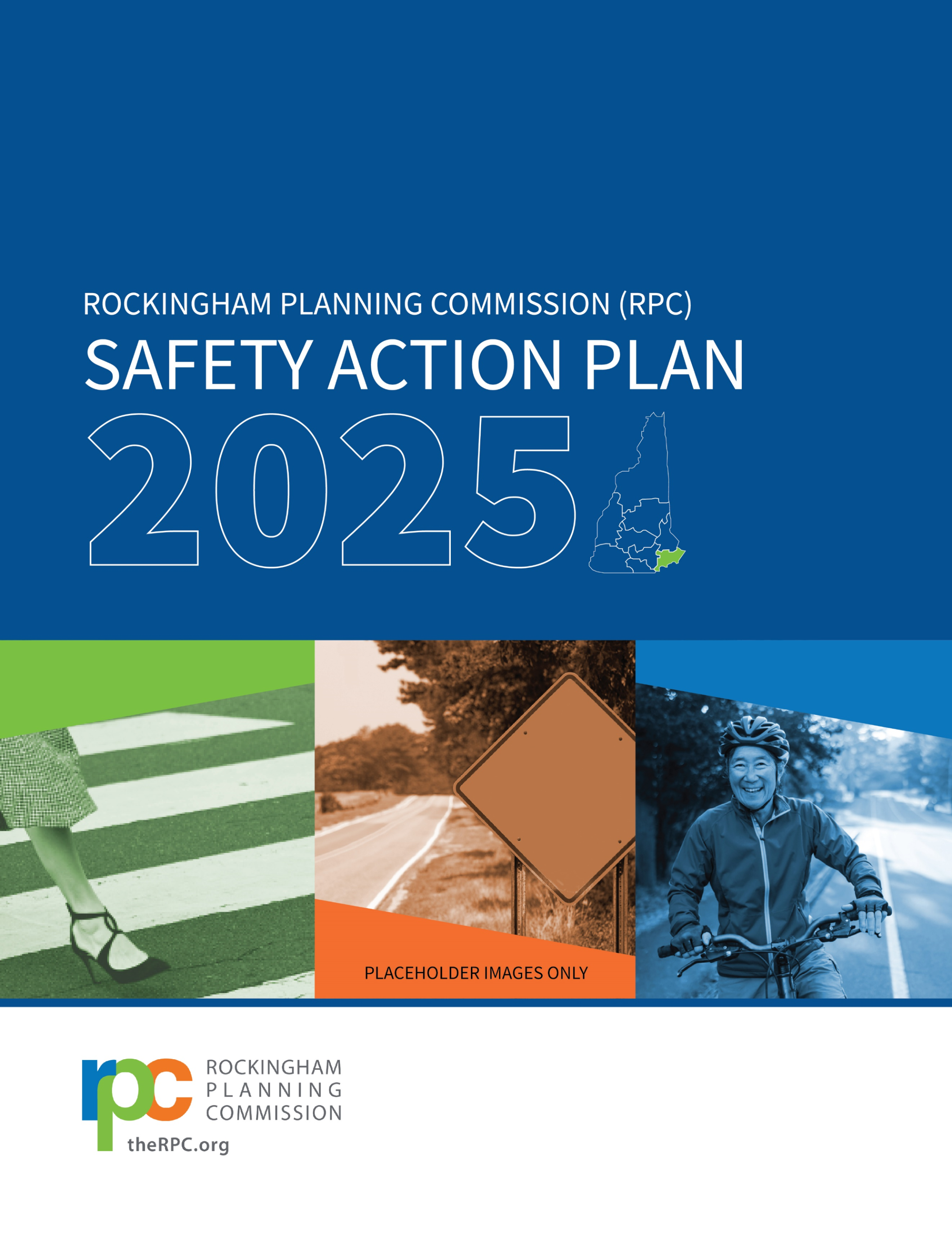Regional Safety Action Plan

The MPO has identified transportation safety as a priority for the region and, utilizing funds provided through the FHWA Safe Streets and Roads for All (SS4A) program, developed the Regional Safety Action Plan (RSAP). The RSAP forms a basic building block to focus efforts on significantly improving transportation safety. The result is a comprehensive safety plan aimed at reducing and eliminating serious-injury and fatal crashes affecting all roadway users. The RSAP uses data analysis to characterize roadway safety problems and strengthen a community’s approach through projects and strategies that address the most significant safety risks. The RSAP is guided by the Safe System Approach, which involves a paradigm shift to improve safety culture, increase collaboration across all safety stakeholders, and refocus transportation system design and operation on anticipating human mistakes and lessening impact forces to reduce crash severity and save lives.
The RSAP establishes a Vision, Mission, and Goal in committing the MPO to improve transportation safety:
Vision: By employing a comprehensive and systematic approach, we will utilize data-driven methods to identify and implement effective countermeasures aimed at reducing crashes in the RPC region.
Mission: Encourage and maintain cooperation among private and public stakeholders in implementing the 4 E's strategies—education, enforcement, engineering, and emergency response—to cultivate a safety culture where even one death on RPC region roadways is unacceptable.
Goal: Reduce the number of fatalities and serious injuries by 50% by 2035, working toward 0 by 2050.

The Regional Safety Action Plan was adopted by the MPO on April 9, 2025. The document is currently undergoing final revisions and formatting and will be available by April 30, 2025. In the interim, the draft RSAP is linked below.
Draft RPC Regional Safety Action Plan
The RSAP is a strategic document that does not include specific projects anticipated to improve safety. Instead, the MPO Long Range Transportation Plan and Transportation Improvement Program will identify safety projects. The MPO System Performance Report, produced in conjunction with LRTP and TIP updates,will include more detailed safety target tracking that will align with the focus areas and trends identified in the RSAP.
Self-Assessment for SS4A Grant Eligibility
With the adoption of the Regional Safety Action Plan, RPC communities are now eligible to apply for demonstration and implementation grants through the SS4A program. The grant application requires a self-assessment of eligibility with the prerequisites listed below. How the RSAP incorporates those aspects is included in red text.
Required:
Multimodal, systemic roadway safety analysis with mapping - The RSAP includes a multimodal and systemic roadway safety analysis.
A list of projects and strategies identified in the plan - The RPC RSAP includes strategies with projects listed in the MPO LRTP and TIP.
Publication or updates between 2020 and June 26, 2025 - The RSAP was adopted on April 9, 2025 and published on April 30, 2025.
Plus at least 3 of the following:
Leadership commitment to eliminate roadway fatalities and serious injuries, and a safety goal - The RSAP includes a commitment to reduce roadway fatalities and serious injuries by 50% by 2035 working towards eliminating them by 2050.
Task force responsible for Action Plan development, implementation, and monitoring - The MPO will utilize the Transportation Advisory Committee and Policy Committee as the responsible entities.
Meaningfully engaged the public, stakeholders, and partner agencies - The RSAP included extensive outreach and engagement with the public, stakeholders (communities, bike/pedestrian advocates, social services agencies), and partner agencies including NHDOT, NH Department of Safety, the Office of Highway Safety, and COAST.
Assessment of and approach to update existing plans, policies, guides - The RSAP includes strategies that address state and local policies.
Metrics to assess progress over time - The RSAP includes the overall goal to measure progress against as well as metrics associated with each of the focus areas.
Safe Streets and Roads For All (SS4) Planning Grant
The Safe Streets and Roads for All (SS4A) grant program was established as part of the Bipartisan Infrastructure Law (BIL) in 2022. SS4A provides $5 billion in appropriated funds over 5 years, 2022-2026 to fund regional, local, and tribal initiatives to prevent serious injuries and death from roadway crashes. Grant funding can be obtained for the purpose of developing Safety Action Plans for a municipality or region or for implementing project proposals included in a Safety Action Plan.
RPC was awarded a planning grant from round one of SS4A to develop regional Safety Action Plans for the four New Hampshire MPOs (NRPC, RPC, SNHPC, and SRPC). Safety Action Plans are comprehensive safety plans intended to reduce or eliminate serious injury and fatal roadway crashes through the development of a data-driven and holistic strategy in a transparent and inclusive process. Safety Action Plans include a set of required components and are a prerequisite for applying for SS4A Implementation Grant funding.
Visit USDOT's SS4A website for further information: https://www.transportation.gov/grants/SS4A
Request for Proposals
As part of the SS4A grant, RPC is requesting assistance to facilitate the efficient development of Safety Action Plans for the four MPOs. The linked document below includes the details of this RFP as well as the basic scope and tasks to be accomplished.
Request for Proposals - MPO Safety Action Plans (Released 9/20/2023)
Important Dates
| RFP Released: | September 20, 2023 |
| Technical Questions Due: | October 4, 2023 |
| Responses to Technical Questions posted: | October 6, 2023 |
| Proposals due to RPC: | October 13, 2023 |
RFP Technical Questions and Responses
Posted October 6, 2023 at 2:35 PM
Question 1: Page 1 of the RFP references a budget exhibit; however, a budget is not included in the list of items required on page 2. Can you confirm that a budget is not required?
- Response: A budget exhibit is not required. The inclusion of “budget exhibits” in the fourth paragraph on page 1 is an artifact from an earlier iteration of the RFP that was inadvertently left in the document. At the same time, the amount of funding available for the project is set in the RFP and it will be expected that proposals will understand that limitation. Once a proposal has been selected, a negotiation process will be undertaken to ensure that the scope, schedule, and costs are detailed, documented, and acceptable to all parties.
Question 2: Page 2 of the RFP references a proposed schedule and work plan, are these included in the 20-page limit?
- Response: The proposed schedule and work plan for the proposal should be included within the 20-page limit.
Question 3: Would it possible to include resumes for key staff within an appendix that is exclusive of the 20-page limit, as long as we include a description of key individuals' roles and experiences within the 20 pages?
- Response: The RFP states that the 20-page limit is inclusive of resumes.
Question 4: In addition to the relevant projects listed within the 20 pages of the proposal, would it also be ok to include a supplemental list of relevant Safety Action Plan projects within an Appendix, exclusive of the 20-page limit?
- Response: The RFP states that the 20-page limit is inclusive of firm experience. Work on Safety Action Plans and related projects by key staff for this proposal should be highlighted when discussing firm experience.
Question 5: Page 2 of the RFP references a DBE Utilization Plan, is a DBE a requirement for the project? And would its inclusion impact the proposal evaluation scoring?
- Response: DBE utilization is not a requirement of the RFP.

